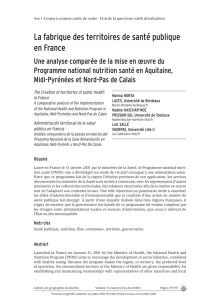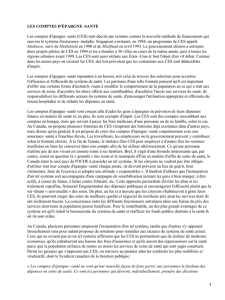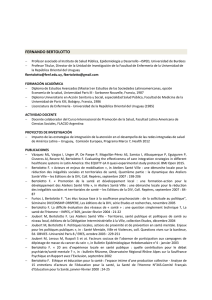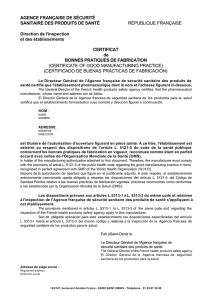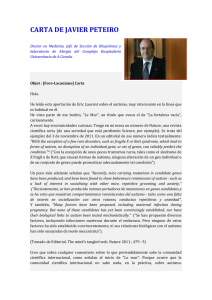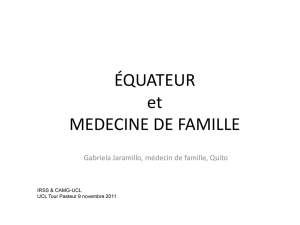Policy and Practice Towards evidence
Anuncio
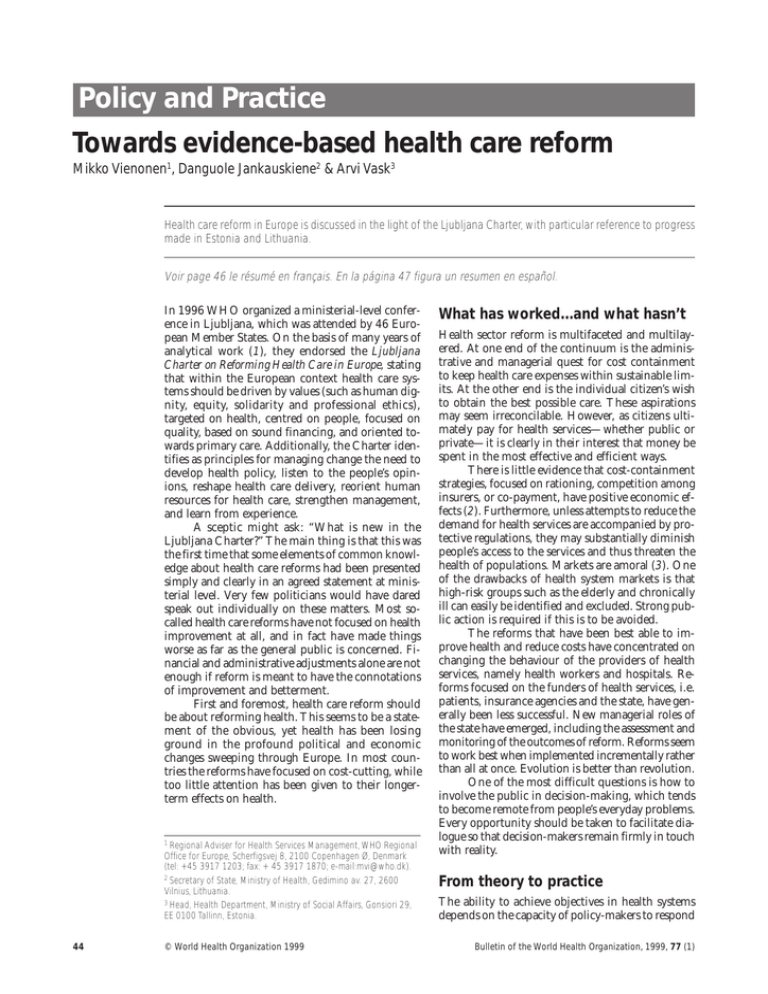
Policy and Practice Towards evidence-based health care reform Mikko Vienonen1, Danguole Jankauskiene2 & Arvi Vask3 Health care reform in Europe is discussed in the light of the Ljubljana Charter, with particular reference to progress made in Estonia and Lithuania. Voir page 46 le résumé en français. En la página 47 figura un resumen en español. In 1996 WHO organized a ministerial-level conference in Ljubljana, which was attended by 46 European Member States. On the basis of many years of analytical work (1), they endorsed the Ljubljana Charter on Reforming Health Care in Europe, stating that within the European context health care systems should be driven by values (such as human dignity, equity, solidarity and professional ethics), targeted on health, centred on people, focused on quality, based on sound financing, and oriented towards primary care. Additionally, the Charter identifies as principles for managing change the need to develop health policy, listen to the people’s opinions, reshape health care delivery, reorient human resources for health care, strengthen management, and learn from experience. A sceptic might ask: “What is new in the Ljubljana Charter?” The main thing is that this was the first time that some elements of common knowledge about health care reforms had been presented simply and clearly in an agreed statement at ministerial level. Very few politicians would have dared speak out individually on these matters. Most socalled health care reforms have not focused on health improvement at all, and in fact have made things worse as far as the general public is concerned. Financial and administrative adjustments alone are not enough if reform is meant to have the connotations of improvement and betterment. First and foremost, health care reform should be about reforming health. This seems to be a statement of the obvious, yet health has been losing ground in the profound political and economic changes sweeping through Europe. In most countries the reforms have focused on cost-cutting, while too little attention has been given to their longerterm effects on health. 1 Regional Adviser for Health Services Management, WHO Regional Office for Europe, Scherfigsvej 8, 2100 Copenhagen Ø, Denmark (tel: +45 3917 1203; fax: + 45 3917 1870; e-mail:[email protected]). 2 Secretary of State, Ministry of Health, Gedimino av. 27, 2600 Vilnius, Lithuania. 3 Head, Health Department, Ministry of Social Affairs, Gonsiori 29, EE 0100 Tallinn, Estonia. 44 © World Health Organization 1999 What has worked...and what hasn’t Health sector reform is multifaceted and multilayered. At one end of the continuum is the administrative and managerial quest for cost containment to keep health care expenses within sustainable limits. At the other end is the individual citizen’s wish to obtain the best possible care. These aspirations may seem irreconcilable. However, as citizens ultimately pay for health services—whether public or private—it is clearly in their interest that money be spent in the most effective and efficient ways. There is little evidence that cost-containment strategies, focused on rationing, competition among insurers, or co-payment, have positive economic effects (2). Furthermore, unless attempts to reduce the demand for health services are accompanied by protective regulations, they may substantially diminish people’s access to the services and thus threaten the health of populations. Markets are amoral (3). One of the drawbacks of health system markets is that high-risk groups such as the elderly and chronically ill can easily be identified and excluded. Strong public action is required if this is to be avoided. The reforms that have been best able to improve health and reduce costs have concentrated on changing the behaviour of the providers of health services, namely health workers and hospitals. Reforms focused on the funders of health services, i.e. patients, insurance agencies and the state, have generally been less successful. New managerial roles of the state have emerged, including the assessment and monitoring of the outcomes of reform. Reforms seem to work best when implemented incrementally rather than all at once. Evolution is better than revolution. One of the most difficult questions is how to involve the public in decision-making, which tends to become remote from people’s everyday problems. Every opportunity should be taken to facilitate dialogue so that decision-makers remain firmly in touch with reality. From theory to practice The ability to achieve objectives in health systems depends on the capacity of policy-makers to respond Bulletin of the World Health Organization, 1999, 77 (1) Towards evidence-based health care reform flexibly and creatively to the policy environment they confront. Cross-national learning about reform experiences is an essential element in this process, as is the adaptation and adjustment of reform mechanisms to accommodate local circumstances. While the basic principles of health reform are universally valid, their application varies with each country’s needs and expectations and with the understanding of reform issues by politicians, health professionals and society as a whole. Particular difficulties have arisen in Central and Eastern Europe and the newly independent states of the former Soviet Union. A major contributory factor has been the deterioration of economic circumstances, output having declined and with it the tax base. Failing state enterprises and increased demand for compensatory social expenditure has exacerbated the fiscal burden on most transitional economies. Strong social and economic pressures are building up in many of these countries. The medical profession, moreover, has been very vocal in promoting changes that would strengthen the position of doctors. The pendulum continues to swing: dissatisfied with an initial position, policy-makers set out to make fundamental changes, then move in the reverse direction as the shortcomings and problems associated with the changes become apparent. The countries of Europe are in various stages of this cycle. Several Western European countries are setting out on major experiments. In Northern Europe, where reform began, there has been a substantial retreat from the most radical position, that of market-oriented incentives, towards the original position of publicly planned coordination and cooperation. In some of the newly independent states there is a tendency to compare today’s extremely difficult conditions with those of the Soviet period, when the health systems as least functioned, and to hesitate about how to proceed. A health care reform laboratory Being small can sometimes be an advantage. In spite of economic constraints, the Baltic countries have made remarkable progress in reorganizing their health care delivery and financing systems. Mistakes have been made, but in the light of them reassessments have been made and corrective measures taken to the extent politically possible. Estonia and Lithuania have received technical assistance and material aid from major international and donor agencies, and have been closely involved in WHO networks and engagements, including the analysis and preparation for the Ljubljana Conference and Charter. This has been an important factor, together with internal motivation and determination, in both countries’ progress in health development. They have not allowed themselves to be unduly distracted from the main issues by the plethora of actors who sometimes advocate and, inBulletin of the World Health Organization, 1999, 77 (1) deed, seek to impose their own values and systems. Estonian and Lithuanian health administrators and planners realized at an early stage that copying others was not desirable and that quick fixes did not exist. Thus, for instance, up to the present there has been only a moderate degree of privatization of health care institutions. Both countries have given special attention to reform of health care delivery. Lithuania has developed a strong national health policy in collaboration with all major interest groups. In addition to the measures taken in primary care, public health and the pharmaceutical sector, a very important principle was introduced for the remuneration of inpatient care providers, involving performance-related payment (4). This is intended to be the main tool for increasing the productivity of health care providers. Payments to hospitals are based on a cost-per-case system, cases being classified in 50 diagnostic groups. The number of cases treated is contractually agreed between each health facility and the State Patient Fund, a newly established social health insurance system. There is a ceiling on the total payments that the Fund can make, and if the institutions increase their throughput of cases the cost per case is proportionately reduced. A new payment system has also been developed for outpatient services in Lithuania. In the first half of the 1990s, there was strong support, especially from physicians, for adopting fee-for-service remuneration on the German model. A need was felt to increase physicians’ productivity, to improve patient care, to reduce under-the-table payments, and to increase doctors’ job satisfaction. However, the economic recession and a dramatically reduced public health care budget demonstrated the importance of financial affordability and the desirability of concentrating on health promotion and health education. WHO drew attention to the disadvantages of creating a payment system that rewarded maximization of the volume of medical services aimed at treating illness. The cautious approach was strongly supported by WHO and tied in with the principles of the Ljubljana Charter. A mixed formula for payment of physicians was initially agreed on, whereby about 70% consisted of capitation, based on the number of people on the lists of doctors at the first-contact level, and additional, clearly specified items were paid for on a fee-for-service basis. In practice, however, a system based entirely on capitation was adopted in 1997, and the fee-for-service component is expected to be introduced gradually as the system develops. Time will show how well the new scheme performs, but the focus on the delivery side of services has a much better chance of success than would be the case if the system were wholly at the mercy of market forces. This transitional solution does not limit access to health care but does contain and balance the health care budget. Estonia has been very active in establishing a functioning family doctor system. The Department of Polyclinic and Family Medicine was set up in the Faculty of Medicine of the University of Tartu, and 45 Policy and Practice a two-year modular training course in general practice was introduced for polyclinic interns, paediatricians and surgeons who had worked during the Soviet period. Some 300 family doctors have been trained and 200 graduate annually. It is expected that the country’s requirements in this area will be met by 2002, when there should be 800 family doctors, i.e. one per 1800 inhabitants. A three-year residency programme has been developed in order to sustain the pool. In 1997 it was decided to set up a family doctor system throughout Estonia. This was important in order to provide working opportunities for the newly retrained family doctors. With the help of the European Union and substantial WHO involvement, a comprehensive plan for rapid transition was prepared. This consisted of registering patients with individual family doctors, establishing a new remuneration system for the doctors, and defining the profile of work and equipment needed. The aim has been to put primary care at the forefront of the health care system. The new arrangements underline the role of the family doctor at the first-contact level. Community care, health promotion and primary care nursing still need to be strengthened. In some parts of Estonia the secondary-level polyclinics were hostile to the new system. However, the backing of WHO and the influence of the Ljubljana Charter made it possible to proceed despite the opposition. The strong backing of all European Member States for the Ljubljana Charter has helped to return health itself (rather than economics and politics) to centre stage in the European debate on health care reform. WHO’s Regional Office for Europe is taking the lead in working with countries to build their health care reforms, using the scientific and ethical tools that have been jointly developed. The renewal of the health-for-all policy at both the global and the regional levels can further strengthen this movement if health care systems are seen as an essential element and actor, indeed as a change agent in the policy. The policy pendulum, the difficulties of policy transfer, and the lack of convergence should not lead policy-makers to believe that health care reform is futile or that effective solutions cannot be found. The European experience and the outcome of recent supply-side initiatives have demonstrated that health care reform can succeed as well as fail, can be moderate as well as radical, can strengthen primary care and equity as well as harming them, and can reinforce the moral underpinnings of the welfare state as well as eroding them. About 20 European countries have already chosen to publicize the Ljubljana Charter. Since 1996 the Charter and the analysis associated with it have been used by health sector politicians, administrators, professional groups and grass-roots organizations in support of their arguments with ministries of finance and, particularly, with proponents of unrestrained privatization. Even WHO is now in a better position to provide advice to governments on these matters. Some countries are clearly benefiting from putting the Ljubljana Charter into practice while others are not yet doing so. For WHO it is vital to concentrate on the essential issues because the scarcity of resources does not allow action on a wider front. The Charter can serve as a beacon guiding navigators across difficult waters but is no substitute for an experienced crew and a sturdy vessel. ■ Résumé Vers une réforme des systèmes de santé fondée sur des faits concrets En 1996, l’OMS a organisé une conférence ministérielle à Ljubljana au cours de laquelle la Charte de Ljubljana sur la réforme des services de santé en Europe a été approuvée; cette Charte stipule que dans le contexte européen, la réforme des systèmes de santé devait être guidée par certaines valeurs (dignité humaine, équité, solidarité et éthique professionnelle), être axée sur la santé, centrée sur l’individu, inspirée par un souci de qualité, être financièrement viable et orientée vers les soins de santé primaires. Il est également ressorti que la gestion du changement est en fin de compte l’épreuve décisive de toute réforme. D’un côté, il y a cette tendance, dictée par des impératifs administratifs et gestionnaires, à réduire les coûts; de l’autre, il y a l’individu qui souhaite obtenir les meilleurs soins possibles. Il ne semble guère que le fait d’insister sur le rationnement, la concurrence entre compagnies d’assurance ou le copaiement ait des effets positifs sur les réductions de coût, et à moins d’être accompagnées de mesures de protection, ces dispositions risquent fort de menacer la santé des populations. Les réformes qui ont le mieux 46 réussi à améliorer la santé et à réduire les coûts sont celles qui se sont attachées à modifier les comportements des agents de santé et du personnel hospitalier. Les petits Etats de l’Europe centrale et de l’Est sont devenus des «laboratoires de réformes du secteur de la santé». L’Estonie et la Lituanie, deux petits Etats baltes, se sont particulièrement concentrés sur la réforme des prestations de santé. La Lituanie a su se doter d’une politique de santé nationale efficace et a entrepris des réformes touchant les soins de santé primaires, la santé publique et le secteur pharmaceutique. Les sommes perçues par les hôpitaux sont calculées sur une base forfaitaire par cas et la rémunération des généralistes repose sur la capitation, contrairement aux recommandations des groupes de pression médicaux qui étaient favorables à la rémunération à l’acte. L’Estonie a instauré un système national d’assurance-maladie obligatoire pour la population et non sélectif et non concurrentiel pour les compagnies d’assurance. Le médecin de famille est considéré comme le pivot du futur système de soins de santé en Estonie, ce pays ayant Bulletin of the World Health Organization, 1999, 77 (1) Towards evidence-based health care reform judicieusement mis en place des cours de formation universitaire de haut niveau à l’intention des généralistes. Dans un deuxième temps, un réseau de médecins de famille a été créé et une méthode de rémunération motivante faisant appel au système national d’assurance-maladie a été mise en place. Les hôpitaux et les polycliniques du niveau secondaire, hostiles à ce nouveau système qui menaçait leur autorité, ont tenté de gagner le public à leur cause. Mais le Gouvernement estonien est attaché à la réforme des soins de santé primaires, et les réformes progressent avec le concours de l’OMS. Les exemples de l’Estonie et de la Lituanie montrent les difficultés pratiques que pose la gestion des changements. Administrateurs et responsables politiques nationaux peuvent être largement aidés par des instruments internationaux comme la Charte de Lujbljana et aussi par l’analyse que l’OMS peut faire des autres réformes en cours : un moyen pouvant atténuer les effets de balancier inutiles qui, régulièrement, entachent les réformes du secteur de la santé des pays de l’Europe centrale et de l’Est. Resumen Hacia una reforma de la atención de salud basada en pruebas En 1996, la OMS organizó una conferencia de nivel ministerial en Liubliana que adoptó la Carta de Liubliana sobre la reforma de la atención de salud en Europa, en la que se declara que en el contexto europeo los sistemas de atención sanitaria deben estar guiados por valores (como la dignidad humana, la equidad, la solidaridad y la ética profesional), enderezados a la salud, centrados en las personas, focalizados en la calidad, basados en una sólida financiación, y orientados hacia la atención primaria. También se llegó a la conclusión de que la gestión del cambio es la prueba decisiva de toda reforma. En un extremo de la cadena se halla el empeño a nivel administrativo y gerencial por contener los costos, y en el otro el deseo de cada ciudadano de obtener la mejor atención posible. Hay pocos indicios de que la insistencia en el racionamiento, la competencia entre aseguradores o los sistemas de copago tenga un efecto positivo en la contención de costos, y de no estar acompañadas por reglamentaciones de protección, esas medidas pueden constituir una grave amenaza para la salud de la población. Las reformas que con mayor éxito han permitido mejorar la salud y reducir los costos se han concentrado en el cambio del comportamiento de los trabajadores de la salud y los hospitales. Los pequeños países de Europa central y oriental se han convertido en «laboratorios de la reforma de la atención de salud». Estonia y Lituania, dos pequeños Estados bálticos, han otorgado especial atención a la reforma de la prestación de asistencia sanitaria. Lituania ha elaborado una sólida política sanitaria nacional y reformado la atención primaria, la salud pública y el sector farmacéutico. Los hospitales cobran según el costo por caso y los médicos generalistas son remunerados por lo común conforme al sistema de capitación, contrariamente al deseo de los grupos de presión médicos que propugnaban un método basado en el pago por servicios prestados. Estonia estableció un sistema de seguro nacional de salud que no permite a los aseguradores la opción de retiro ni la competencia para apoderarse de las mejores partes de mercado. El médico de familia se considera una pieza fundamental del futuro sistema de atención de salud de Estonia, que ha comenzado a construirse a partir de la base adecuada, a saber, estableciendo una formación universitaria de alto nivel para los especialistas en medicina general. En la segunda fase de la reforma, se creó una red de médicos de familia y se instauró un sistema de remuneración atractivo mediante el seguro nacional de salud. Los hospitales y policlínicas de nivel secundario han considerado esta evolución como una amenaza para su antigua hegemonía y han tratado de ganarse al público. Sin embargo, el Gobierno de Estonia está comprometido con la reforma de la APS y, con el apoyo de la OMS, las reformas siguen adelante. Los ejemplos de Estonia y Lituania muestran lo difícil que es en la práctica la gestión del cambio. Para los políticos y administradores nacionales pueden ser una considerable ayuda las declaraciones de consenso internacionalmente acordadas, como la Carta de Liubliana, lo mismo que los elementos concretos que aporte el análisis de las reformas en curso que está realizando la OMS. Esto puede atenuar el innecesario efecto péndulo, que tan habitualmente acecha a las reformas de la atención de salud en Europa central y oriental. References 1. Saltman RB, Figueras, J. European health care reform; analysis of current strategies. Copenhagen, World Health Organization Regional Office for Europe, 1997 (WHO Regional Publications, European Series, No. 72). 2. Saltman RB, Figueras, J. On solidarity and competition: an evidence-based perspective. Eurohealth, 1996, 2 (4): 19–20. 3. Evans RG. Health care reform: who’s selling the market and why? Journal of public health medicine, 1997, 19 (1): 45–49. Bulletin of the World Health Organization, 1999, 77 (1) 4. Cerniauskas G, Murauskiene L. Reforming the health services in Lithuania. In: Proceedings of a workshop on Reforming the Health Services in the Baltic Countries, 22 August 1996. Copenhagen, Danish Institute for Health Services Research and Development (DSI report 97.08, 1997: 63–73). 47
